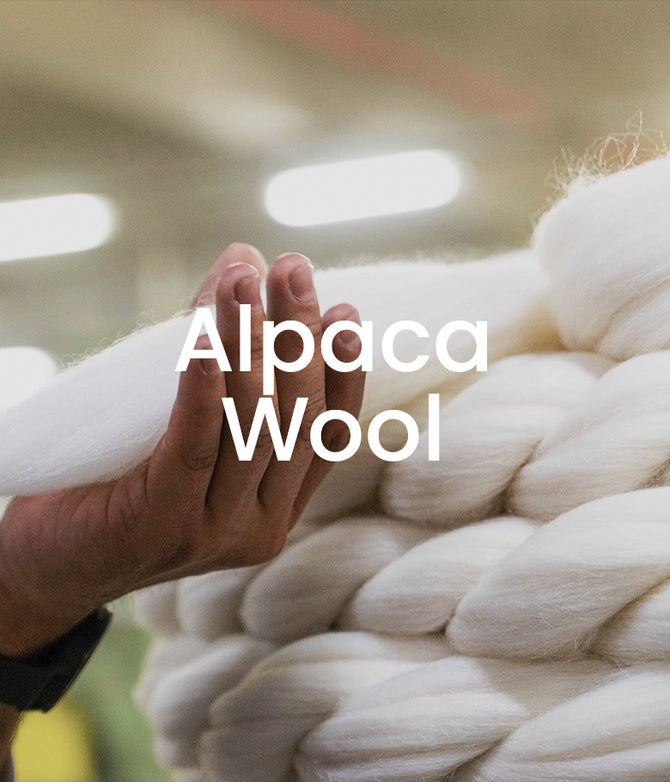Alpaca Wool vs Merino:
Which Is Warmer & Which Is Itchier?
Published Oct 08, 2019 | Updated December 08, 2021
Discover with us the truth about the warmth and itchiness of Alpaca wool compared to merino wool.
- Is Alpaca Wool Itchier Than Merino?
- Is Alpaca Wool Warmer Than Merino?
Alpaca wool
Merino wool
Alpaca wool
Is Alpaca Wool Itchier Than Merino?
NO! Merino feels itchier. Alpaca wool does not feel itchy to most people.
It's important to consider that people with sensitive skin might perceive itchiness differently. What is itchy to one person can feel soft to another. However, to most people, Alpaca wool does not feel scratchy against the skin.
There are three main factors that determine the itchiness of wool against the skin:
- Lanolin content
- Fiber diameter
- Fiber smoothness
1. Lanolin Content
Lanolin is a wax secrete naturally present in sheep wool, produced by the sheep's sebaceous glands. It works as a protective barrier and a moisturizer. Although it is used for some skin care products, it is an allergen for some people.
Unlike sheep, alpacas produce zero to low amounts of lanolin. Their wool has a high moisture resistance which is why they do not need lanolin to keep their wool protected. Without lanolin content, alpaca wool also holds less bacteria and dust, which is why alpaca wool is considered hypoallergenic.
2. Fiber Diameter
Fiber thickness can determine whether it will feel itchy or soft next to skin. Coarse wool fibers feel rather scratchy, while very fine fibers (below 21 microns) feel much softer.


Alpaca fibers come in different diameters which means that not all alpaca wool has the same softness. Same goes for merino wool. Alpaca and baby alpaca wool are the finest with diameters of less than 21 microns, feeling ultra soft against the skin and therefore are unlikely to feel itchy.
3. Fiber Smoothness

Wool fibers have microscopic scales which protrude from the surface of the fiber, creating a prickly feeling. The smaller and flatter the scales, the smoother the fiber.
The scales on alpaca fibers are small and sit flat against the surface of the fiber, meaning alpaca wool doesn't cause a prickly sensation. Merino wool has larger overlapping scales that can cause some itchiness.
Sheep wool has very prominent scales and is coated in lanolin. Further – excluding merino – sheep fibers tend to be on the coarser end of the spectrum. All this leads to that characteristic wooly jumper itch.
However, merino wool used in outdoor clothing tends to be very fine (around 19-20 microns in diameter) and has usually been treated to remove the lanolin and fiber scales, so it feels much softer and less itchy than other types of sheep’s wool. But alpaca wool doesn’t need any special treatment: it’s naturally super soft and even less itchy.

At Arms of Andes we use the finest Alpaca Wool sourced in the Peruvian Andes. The Andean alpacas naturally developed over thousands of years in harsh conditions in high altitudes, creating the perfect fiber for outdoor gear that helps you stay protected in all conditions. Discover out outdoor apparel.

Is Alpaca Wool Warmer Than Merino?
YES! Alpaca wool is even warmer than merino.
Merino works as a great insulator even when it’s wet. But the difference is in the internal structure of the fibers: Alpaca fibers have “semi-hollow” cores, while merino relies only on the crimp of the fibers to trap warm air. This difference also means merino wool is heavier than alpaca wool. Let's explain this.
Wool fibers work so well as insulators as they are not straight, but instead have a slight wave (known technically as the “crimp”), along their length. The waviness of the fibers traps tiny pockets of air between the fibers in a weave; these air pockets are heated by your body and stay warm.
The internal structure (core) of wool also has an impact on warmth. In most wool fibers, the filaments are packed together, making them appear to have a solid cross-section under the microscope. Fibers that have less dense areas running down the center, so they can be considered “semi-hollow”, not only trap air in between them, but the “hollow” areas heat up too!
Merino wool has solid fibers and alpaca wool has semi-hollow fibers, which means that alpaca wool is warmer than merino.


Alpaca wool is naturally temperature regulating because of the crimp and semi-hollow core. Alpaca wool clothing traps the heat produced by your body, both inside and in between the fibers.
For this reason, if you leave an alpaca base layer hanging outside, at first touch it feels cool, because the air trapped in the fiber is cool. However, once you put your alpaca base layer on, it warms up very quickly to protect you from the cold. But more than that, our thinner layers can prevent you from overheating in warm weather!
Alpaca wool (particularly the baby alpaca fiber grades) is non-itchy, warm, and performs better than merino and other types of sheep's wool. This makes alpaca wool perfect for your outdoor clothing, hiking socks and even underwear.











